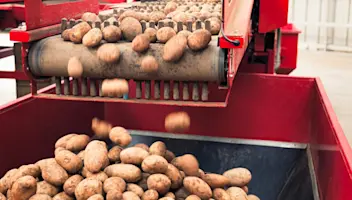Master Yield Management in Food Production: 10 Steps To Competitive Advantage
Master Yield Management in Food Production: 10 Steps To Competitive Advantage
Master Yield Management in Food Production: 10 Steps To Competitive Advantage
23 Nov 2022
Aptean Staff Writer
Think yield analysis is just another metric for your food business to track? You might be failing to capitalize on an opportunity to increase efficiency and boost your revenue.
By moving beyond traditional methods and embracing the scientifically sound approach of using the “yield index,” companies like yours can minimize waste and increase profits.
Read on to learn how you can implement this tool and get the most out of your materials.
Shortcomings of Typical Yield Analysis Processes
Evaluating yield levels is a regular procedure for nearly all food businesses, but in many instances, the only benchmarks used come from historical data. That's to say, the only reference for comparison is past performance—and that’s likely far from what would actually reflect optimal results.
Progress relative to output levels achieved during previous runs is well and good, but ideally, you’d want to compare each yield to an objective standard or “best possible” figure. Of course, that’s not so easy to determine, as some waste is unavoidable, and simply measuring the weight of raw materials to that of finished product isn’t nearly nuanced enough.
Enter Yield Index
Derk Somsen and Anthony Capelle have found the solution via their extensive research. They proved that with the knowledge of a theoretical maximum yield, food businesses can far more effectively cut back on losses and increase profits.
The key is the yield index, defined as:
YIELD INDEX = ACTUAL YIELD / HIGHEST POSSIBLE YIELD
This formula allows for comparison of actual yields against the absolute ideal on a linear scale. Still, you have to solve the problem of defining the best possible result—but this process will enable your business to calculate that figure and implement a program of continual improvement.
"Some waste is unavoidable, and simply measuring the weight of raw materials to that of finished product isn’t nearly nuanced enough."
10 Steps to Competitive Success With Yield Management in Food Production
Somsen and Capelle used the scientific method as their basis for outlining what it takes to put in place a yield analysis program based on the yield index.
Establish a baseline by which you can track your progress. For now, it’s fine to use whatever method is convenient and familiar.
Characterize your raw materials. Think about the various parameters on which your ingredients could be judged. For example, Somsen and Capelle examined potatoes that were intended for French fry production, and they identified bumpiness, thickness of skin, number of eyes, age, average size (and standard deviation of size), orientation during cutting and number of potatoes per kilogram as pertinent factors to consider.
Using the scientific method, characterize your theoretical optimized process: 1) Develop hypotheses for the most efficient manufacturing procedure. Be practical as you go about defining this, but don’t limit the possibilities based on existing constraints and policies; 2) Conduct experiments to test your hypotheses; 3) Observe your results; 4) Draw conclusions and circle in on how and where unwanted losses are occurring.
Implement this optimized process and gather data on your performance. Don’t see any immediate improvement? That’s OK—these figures will act as data points for future analysis.
Using regression analysis and modeling, develop a model based on the data you’ve collected. You should be able to dial in on just how each of your raw material parameters impacts your yields. With this information, build a spreadsheet model that uses those parameters as inputs, and from there you should be able to derive your yield index. For more information, Somsen and Capelle suggest these Applied Linear Statistical Models.
Disseminate this spreadsheet among employees or integrate it into your software so that employees can put it to use. Make sure it’s practical, though—not all parameters of raw materials can be fully assessed with each shipment, so prioritize what’s easily measurable.
Once you’re pleased with the model you’ve created, train employees on this analysis and its importance and set an interval that makes sense for your businesses (by shift, batch, day or week) to perform the calculation for evaluation. Note that yield ratios greater than 1 are technically possible, but they most often indicate inefficient dissection when dealing with protein—examine how the yield index of less valuable parts compares to that of more valuable parts and treat any very high yield indexes with suspicion.
Examine the results of your implementation and further refine your understanding of what processes are resulting in unnecessary loss. Use the 80/20 rule, concentrating on those operations that are generating the highest proportions of unwanted waste. Celebrate your successes to keep enthusiasm for your new methods high.
Set up benchmarks and standards so that everyone in the organization can see for themselves how the new analysis method is impacting your efficiency.
Consider more advanced models that incorporate pre-harvest information from farmers, or develop simulations to gain even greater insight into which processes are pulling your yield index down.
A Tall Task That’s Worth the Effort
Following these steps and successfully putting a yield index analysis procedure in place isn’t easy—Somsen and Capelle estimated it takes a typical production facility 1.5 full-time employees and 1.5 years to complete.
The investment of time and money is considerable, but so are the increases to your efficiency. Remember the French fry producer that Somsen and Capelle worked with? They saw their yield index jump from 0.77 to 0.90 over a 10-year period.
It takes commitment, skills and resources, but implementing this approach can have remarkably positive effects on your margins and profitability without exposing your business to unnecessary risk. An industry-specific enterprise resource planning (ERP) solution like our own Aptean Food & Beverage ERP can ensure the process goes smoothly.
Contact us today to learn how future-proof ERP solutions from Aptean can suit your business’s needs.
Related Content


Get in touch today to speak with an expert in your industry
To grow your business, you need a food ERP built specifically for your industry challenges. We're ready to help—reach out today and we'll help you find the right solution.






